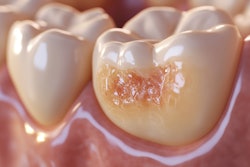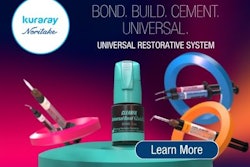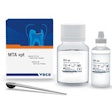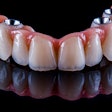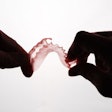Extended use of certain mouth rinses may cause discoloration of CAD-CAM resin-based restorations, with the extent potentially affected by material and rinse type. This study was published recently in the Journal of Prosthetic Dentistry.
For example, CAD-CAM resin-based materials, especially resin nanoceramics (BRC), may show significant color change when exposed to alcohol-containing mouth rinses (LIS), the authors wrote.
"When selecting mouth rinses for patients with these restorations, both the formulation of the mouth rinse and the material's susceptibility to discoloration should be considered along with other clinical factors," wrote the authors, led by Dr. Izim Turker Kader, PhD, of the Bahcesehir University School of Dental Medicine in Turkey (J Prosthet Dent, April 10, 2025).
To evaluate the effects of different mouth rinses, 180 specimens from five CAD-CAM resin-based materials were fabricated, including a polymer-infiltrated ceramic network (ENA), BRC, a resin nanohybrid (GRD), and a resin composite (KZR). A lithium disilicate ceramic (EMX) served as the control group (n = 30), they wrote.
Specimens were immersed in various solutions, including LIS, alcohol-free (ORLB), zinc chloride-containing (PHR), and hypochlorous acid-containing (BRT) mouth rinses and artificial saliva (CON) for 12 hours (t0.5), 2.5 days (t2.5), and 5 days (t5), simulating one, five, and 10 years of clinical exposure.
EMX showed the lowest mean color change (∆E₀₀), while GRD exhibited significantly higher values than ENA and KZR (p < .001). Among the mouth rinses, LIS and ORLB led to significantly higher ∆E₀₀ values compared to PHR, BRT, and CON. In terms of time effects, discoloration at ∆Et₀-t0.5 was significantly lower than at ∆Et₀-t2.5 and ∆Et₀-t5, they wrote.
The highest color change was observed in BRC immersed in LIS, while the lowest occurred in EMX immersed in CON. For material × time interactions, GRD at ∆Et₀-t5 showed the highest ∆E₀₀ value, and EMX at ∆Et₀-t0.5 showed the lowest. All materials except KZR and EMX exhibited color changes exceeding the acceptability threshold (∆E₀₀ = 1.8) when exposed to LIS and ORLB.
However, the study had limitations. Color measurements were taken only against a white background, limiting the accuracy of true color representation, the authors added.
"Prolonged use of certain mouth rinses, depending on their composition, may contribute to the discoloration of CAD-CAM resin-based restorations, with the extent of color change influenced by the material's microstructure," Kader and colleagues wrote.





